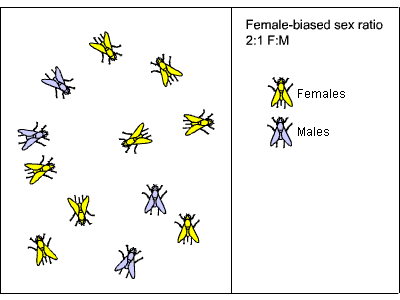Mating Walnut Flies: Background & Setup
The walnut fly (Rhagoletis juglandis) is a small fruit fly that lays its eggs inside the husk of a developing walnut. The males hang around on developing walnuts and wait for females to arrive to lay eggs. Both males and females will mate more than once. Multiple matings mean sperm competition (read more on sperm competition).
The "operational sex ratio" (OSR) can have a big effect on mating behavior. OSR is the relative proportions of sexually active males and females in a population, or at a particular site. Only animals that are ready and willing to mate are counted (read more on sex ratios).
Illustration of female-biased sex ratio (more females than males)

Researchers studying the walnut fruit fly soon noticed something interesting:
once a male and female begin to mate, some of them remain linked for a
relatively long time (>10min), while others mated for a relatively
short period (<3min). What could account for this difference? (read
more on alternative mating strategies).
